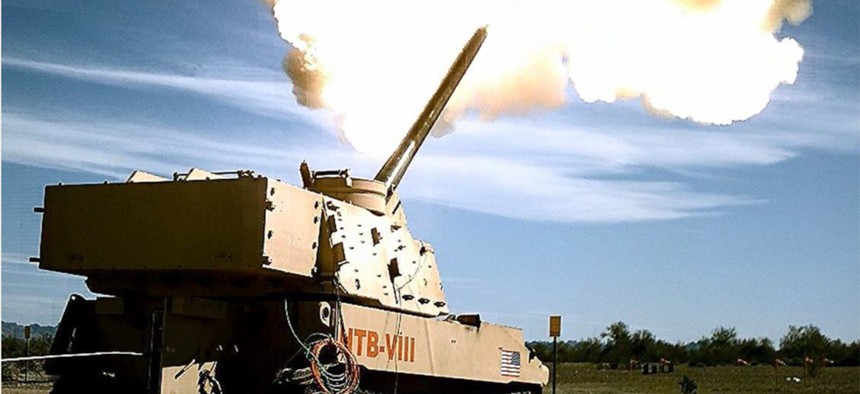
Extended Range Cannon Artillery, or ERCA, cannon at Picatinny Arsenal. US Army / Edward Lopez
The Army Just Tested Its New Supergun
It's the latest weapon meant to intimidate China and Russia: a giant cannon that can fire shells about three times farther than a standard howitzer.
In the tests, conducted at Yuma Proving Ground in Arizona, the XM1299 cannon used a “supercharged” propellant to fire two types of munitions about 65 kilometers — much farther than a traditional howitzer’s 18-kilometer range. The Excalibur precision-guided munition hit a “precise” target, officials said. The other, the rocket-assisted XM1113, was tested for range, not precision, the officials said. It was the longest test yet for the cannon, which is essentially a modernized howitzer being developed under the Extended Range Cannon Artillery program.
Brig. Gen. John Rafferty Jr., who directs the Long Range Precision Fires Cross Functional Team at Army Futures Command, said that the cannon promises a new way to attack targets that lie some 20 to 60 kilometers away. It “allows commanders to attack differently, provides them a weapon system other than helicopters and armed drones to go after targets that are deeper on the battlefield,” he said.
The Army has ordered 18 XM1299s and aims to send them to a battalion in 2023. BAE will serve as the integrator.
“That will give us the opportunity to test the platform in the hands of an operational unit and evaluate the operational concept for support fires at the division level,” said Rafferty. “We’ve proven the capability; we’ve proven the range.”
The Army is also looking at different projectiles, including one that uses a ramjet. Rafferty said he expects a contractor to demonstrate it this year.
The big challenge now is finishing an autoloader that will allow the cannon to fire six to eight rounds per minute — to “deliver that volume of fire to create the effect of mass,” as Rafferty put it: in other words, to devastate an enemy position the way an enormous bomb would. But he cautioned that an autoloader is “not a simple machine.” It has to load the munition, the propellant, and the course-correcting fuze that allows the shell to change direction (slightly) in mid-air.
Work is proceeding at Picatinny Arsenal in New Jersey, where engineers expect to begin lab testing later this year and hope to issue requests for proposals to industry in three to four months.




